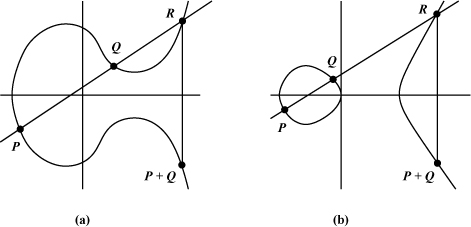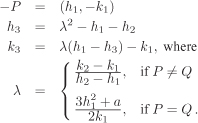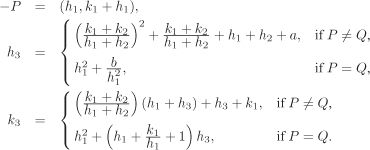*2.11. Elliptic Curves
The mathematics of elliptic curves is vast and complicated. A reasonably complete understanding of elliptic curves would require a book of comparable size as this. So we plan to be rather informal while talking about elliptic curves and about their generalizations called hyperelliptic curves. Interested readers can go through the books suggested at the end of this chapter to learn more about these curves. In this section, K stands for a field (finite or infinite) and ![]() the algebraic closure of K.
the algebraic closure of K.
2.11.1. The Weierstrass Equation
An elliptic curve E over K is a plane curve defined by the polynomial equation
Equation 2.6
![]()
or by the corresponding homogeneous equation
E : Y2Z + a1XYZ + a3YZ2 = X3 + a2X2Z + a4XZ2 + a6Z3.
These equations are called the Weierstrass equations for E. In order that E qualifies as an elliptic curve, we additionally require that it is smooth at all ![]() -rational points (Definition 2.66).[12] Two elliptic curves defined over the field
-rational points (Definition 2.66).[12] Two elliptic curves defined over the field ![]() are shown in Figure 2.1.
are shown in Figure 2.1.
[12] Ellipses are not elliptic curves.
Figure 2.1. Elliptic curves over 
(a) Y2 = X3 – X + 1
(b) Y2 = X3 – X

E contains a single point at infinity, namely ![]() (Exercise 2.97(e)). The set of K-rational points on E in the projective plane
(Exercise 2.97(e)). The set of K-rational points on E in the projective plane ![]() is denoted by E(K) and is the central object of study in the theory of elliptic curves. We shortly endow E(K) with a group structure and this group is used extensively in cryptography.
is denoted by E(K) and is the central object of study in the theory of elliptic curves. We shortly endow E(K) with a group structure and this group is used extensively in cryptography.
Let us first see how we can simplify the equation for E. The simplification depends on the characteristic of K. Because fields of characteristic 3 are only rarely used in cryptography, we will not deal with such fields. Simplification of the Weierstrass equation is effected by suitable changes of coordinates. A special kind of transformation is allowed in order to preserve the geometric and algebraic properties of an elliptic curve.
Theorem 2.44.
|
Two elliptic curves
defined over K are isomorphic (Definition 2.72) if and only if there exist Equation 2.7
|
The theorem is not proved here. Formulas (2.7) can be checked by tedious calculations. A change of variables as in Theorem 2.44 is referred to as an admissible change of variables. We denote this by
(X, Y) ← (u2X + r, u3Y + u2sX + t).
The inverse transformation is also admissible and is given by
![]()
Isomorphism is an equivalence relation on the set of all elliptic curves over K.
Consider the elliptic curve E over K given by Equation (2.6). If char K ≠ 2, the admissible change ![]() transforms E to the form
transforms E to the form
E1 : Y2 = X3 + b2X2 + b4X + b6.
If, in addition, char K ≠ 3, the admissible change ![]() transforms E1 to E2 : Y2 = X3 + aX + b. We henceforth assume that an elliptic curve over a field of characteristic ≠ 2, 3 is defined by
transforms E1 to E2 : Y2 = X3 + aX + b. We henceforth assume that an elliptic curve over a field of characteristic ≠ 2, 3 is defined by
Equation 2.8
![]()
(instead of by the original Weierstrass Equation (2.6)).
If char K = 2, the Weierstrass equation cannot be simplified as in Equation (2.8). In this case, we consider two cases separately, namely a1 ≠ 0 or otherwise. In the former case, the admissible change ![]() allows us to write Equation (2.6) in the simplified form
allows us to write Equation (2.6) in the simplified form
Equation 2.9
![]()
On the other hand, if a1 = 0, then the admissible change (X, Y) ← (X + a2, Y) shows that E can be written in the form
Equation 2.10
![]()
A curve defined by Equation (2.9) is called non-supersingular, whereas one defined by Equation (2.10) is called supersingular.
Now we associate two quantities with an elliptic curve. The importance of these quantities follows from the subsequent theorem. We start with the generic Weierstrass equation and later specialize to the simplified formulas.
Definition 2.76.
|
For the curve given by Equation (2.6), we define the following quantities: Equation 2.11
Δ(E) is called the discriminant of the curve E, and j(E) the j-invariant of E. |
For the special cases given by the simplified equations above, these quantities have more compact formulas as given in Table 2.5.
Theorem 2.45.
|
For the curve E defined by Equation (2.6), the following properties hold:
Proof
|
2.11.2. The Elliptic Curve Group
Consider an elliptic curve E over a field K. We now define an operation (which is conventionally denoted by +) on the set E(K) of K-rational points on E in the projective plane ![]() . This operation provides a group structure on E(K). It is important to point out that this group is not the same as the group DivK(E) of divisors on E(K) (Definition 2.74), since the sum of points we are going to define is not formal. However, there is a connection between these two groups (See Exercise 2.125).
. This operation provides a group structure on E(K). It is important to point out that this group is not the same as the group DivK(E) of divisors on E(K) (Definition 2.74), since the sum of points we are going to define is not formal. However, there is a connection between these two groups (See Exercise 2.125).
Definition 2.77.
|
Let E be the elliptic curve defined by Equation (2.6) and
|
Theorem 2.46.
No simple proof of this theorem is known. Indeed the only group axiom that is difficult to check is associativity, that is, to check that (P + Q) + R = P + (Q + R) for all P, Q, ![]() . An elementary strategy would be to write explicit formulas for (P + Q) + R and P + (Q + R) (using the formulas for P + Q given below) and show that they are equal, but this process involves a lot of awful calculations and consideration of many cases.
. An elementary strategy would be to write explicit formulas for (P + Q) + R and P + (Q + R) (using the formulas for P + Q given below) and show that they are equal, but this process involves a lot of awful calculations and consideration of many cases.
There are other proofs that are more elegant, but not as elementary. One possibility is to use the theory of divisors and is outlined now. It turns out that the Jacobian ![]() has a bijective correspondence with the set E(K) via the map
has a bijective correspondence with the set E(K) via the map ![]() which takes
which takes ![]() to
to ![]() (more correctly to the equivalence class of the divisor
(more correctly to the equivalence class of the divisor ![]() in
in ![]() ). Furthermore,
). Furthermore, ![]() , where the addition on the left is the addition on E(K) as defined above and the addition on the right is that in the Jacobian
, where the addition on the left is the addition on E(K) as defined above and the addition on the right is that in the Jacobian ![]() . By definition,
. By definition, ![]() is naturally an additive Abelian group. It immediately follows that E(K) is an additive Abelian group too. (See Exercise 2.125.)
is naturally an additive Abelian group. It immediately follows that E(K) is an additive Abelian group too. (See Exercise 2.125.)
We now give the formulas for the coordinates of the points –P and P + Q on E(K). The derivation of these formulas for the general case is left to the reader (Exercise 2.102). We concentrate on the important special cases. We assume that P = (h1, k1) and Q = (h2, k2) are finite points on E(K) with Q ≠ –P so that ![]() .
.
If char K ≠ 2, 3 and E is defined by Equation 2.8, we have:

Next, we consider char K = 2 and non-supersingular curves (Equation 2.9). The formulas in this case are:

Finally, for supersingular curves (Equation 2.10) with char K = 2, we have:

We denote by mP the sum P + · · · + P (m times) for a point ![]() and for
and for ![]() . We also define
. We also define ![]() and (–m)P := –(mP) (for
and (–m)P := –(mP) (for ![]() ).
).
Example 2.22.
|
Definition 2.78.
|
Let |
Multiples mP of a point ![]() can be expressed using nice formulas.
can be expressed using nice formulas.
Definition 2.79.
|
For an elliptic curve defined over K by the equation E : f(X, Y) = 0 and for mP = (θm(h, k)/ψm(h, k)2, ωm(h, k)/ψm(h, k)3). The polynomial ψm is called the m-th division polynomial of E. |
Using the addition formula one can verify the following recursive description for ψm and the expressions for θm and ωm in terms of ψm.
Lemma 2.8.
|
For an elliptic curve E defined by the general Weierstrass Equation (2.6) over a field K, the division polynomials ψm,
where di are as in Definition 2.76. The polynomials θm satisfy
and for char K ≠ 2, one has
|
It follows by induction on m that these formulas really give polynomial expressions for ψm, θm and ωm for all ![]() . For even m, the polynomial ψm is divisible by ψ2. Furthermore, for
. For even m, the polynomial ψm is divisible by ψ2. Furthermore, for ![]() the polynomials
the polynomials ![]() defined as
defined as
![]()
can be expressed as polynomials in x only. These univariate polynomials ![]() are easier to handle than the bivariate ones ψm and, by an abuse of notation, are also called division polynomials. The degrees of
are easier to handle than the bivariate ones ψm and, by an abuse of notation, are also called division polynomials. The degrees of ![]() satisfy the inequality:
satisfy the inequality:
![]()
Points of E[m] can be characterized in terms of the division polynomials:
Theorem 2.47.
|
Ler |
We finally define polynomials ![]() as follows. If char K ≠ 2, then
as follows. If char K ≠ 2, then ![]() for all
for all ![]() . On the other hand, for char K = 2 and for non-supersingular curves over K we already have
. On the other hand, for char K = 2 and for non-supersingular curves over K we already have ![]() (Exercise 2.107), and it is customary to define fm(x) := ψm(x, y) for all
(Exercise 2.107), and it is customary to define fm(x) := ψm(x, y) for all ![]() . By further abuse of notations, we also call fm the m-th division polynomial of E.
. By further abuse of notations, we also call fm the m-th division polynomial of E.
2.11.3. Elliptic Curves over Finite Fields
In this section, we take ![]() , a finite field of cardinality q and characteristic p. We do not deal with the case p = 3. Let E be an elliptic curve defined over
, a finite field of cardinality q and characteristic p. We do not deal with the case p = 3. Let E be an elliptic curve defined over ![]() . If p > 3, we assume that E is defined by Equation (2.8), whereas for p = 2, we assume that E is defined by Equation (2.10) or Equation (2.9) depending on whether E is supersingular or not.
. If p > 3, we assume that E is defined by Equation (2.8), whereas for p = 2, we assume that E is defined by Equation (2.10) or Equation (2.9) depending on whether E is supersingular or not.
Since ![]() is a subset of
is a subset of ![]() , the cardinality
, the cardinality ![]() is finite. The next theorem shows that
is finite. The next theorem shows that ![]() is quite close to q.
is quite close to q.
Theorem 2.48. Hasse’s theorem
|
|
The implication of this theorem is that the possible cardinalities of ![]() lie in a rather narrow interval
lie in a rather narrow interval ![]() . If q = p is a prime, then for every n,
. If q = p is a prime, then for every n, ![]() , there is at least one curve E with
, there is at least one curve E with ![]() . Moreover, the values of
. Moreover, the values of ![]() are distributed almost uniformly in the interval
are distributed almost uniformly in the interval ![]() . However, if q is not a prime, these nice results do not continue to hold.
. However, if q is not a prime, these nice results do not continue to hold.
Definition 2.80.
|
If t = 1 (that is, if |
Anomalous and supersingular curves are cryptographically weak, because certain algorithms are known with running time better than exponential to solve the so-called elliptic curve discrete logarithm problem over these curves. Determination of the order ![]() gives t from which one can easily check whether E is anomalous or supersingular. If p = 2, we have an easier check for supersingularity.
gives t from which one can easily check whether E is anomalous or supersingular. If p = 2, we have an easier check for supersingularity.
Proposition 2.35.
|
An elliptic curve E over a finite field of characteristic 2 is supersingular if and only if j(E) = 0 or, equivalently, if and only if a1 = 0 in Equation (2.6). |
For arbitrary characteristic p, we have the following characterization.
Proposition 2.36.
|
An elliptic curve E over |
By Theorem 2.38, the group ![]() is always cyclic. However, the group
is always cyclic. However, the group ![]() is not always cyclic, but is of a special kind. We need a few definitions to explain the structure of
is not always cyclic, but is of a special kind. We need a few definitions to explain the structure of ![]() . The notion of internal direct product for multiplicative groups (Exercise 2.19) can be readily applied to additive groups as follows.
. The notion of internal direct product for multiplicative groups (Exercise 2.19) can be readily applied to additive groups as follows.
Definition 2.81.
Theorem 2.49. Structure theorem for finite Abelian groups
Theorem 2.50. Structure theorem for 
|
The elliptic curve group |
Once we know the order ![]() of the group
of the group ![]() , it is easy to compute the order of
, it is easy to compute the order of ![]() as the following theorem suggests.
as the following theorem suggests.
Theorem 2.51.
|
Let α, |
Exercise Set 2.11
| 2.100 | Show that the following curves over K are not smooth (and hence not elliptic curves): |
| 2.101 |
|
| 2.102 | Let P = (h1, k1) and Q = (h2, k2) be two points (different from
|
| 2.103 | Let |
| 2.104 | Assume that char K ≠ 2, 3 and consider the elliptic curve E given by Equation (2.8). Let K[E] be the affine coordinate ring and K(E) the field of rational functions on E.
|
| 2.105 | Show that the division polynomials
where F = 4x3 + d2x2 + 2d4x + d6. |
| 2.106 | Write the recursive formulas for the division polynomials ψm(x, y) and |
| 2.107 | Write the recursive formulas for the division polynomials ψm(x, y) and |
| 2.108 | Consider the elliptic curve defined over the field Ea,b : Y2 = X3 + aX + b. Verify the following assertions: (You may write a computer program.)
|
| 2.109 | Consider the representation of Ea,b : Y2 + XY = X3 + aX2 + b. Verify the following assertions: (You may write a computer program.)
|
| 2.110 | Consider the representation of Ea,b,c : Y2 + aY = X3 + bX + c. Verify the following assertions: (You may write a computer program.)
|
| 2.111 | Consider the elliptic curve E : Y2 + XY = X3 + X2 + 1 defined over
where r = ⌊n/2⌋. [H] Conclude that E is anomalous over |
| 2.112 | Let K be a finite field of characteristic ≠ 2, 3 and E : Y2 = X3 + aX + b an elliptic curve defined over K. Prove that:
|
| 2.113 | Let E : Y2 + XY = X3 + aX2 + b be a non-supersingular elliptic curve defined over
|
| 2.114 | Let E : Y2 + aY = X3 + bX + c be a supersingular elliptic curve over
|
| 2.115 |
|
| 2.116 | Let
|
| 2.117 | A Weierstrass equation of an elliptic curve defined over a field K is said to be in the Legendre form, if it can be written as
Equation 2.12
for some |





